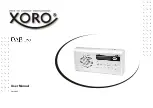
Information
To display information about the selected radio station, briefly press the INFO button. Depending on the station, you can call up information about the frequency, radio text, date
or time on the display by briefly pressing the INFO button again. You can quit this function by pressing the BACK button.
Sleep Timer
The device is equipped with a sleep timer (Sleeptimer). When the function is activated, the device can automatically switch to standby mode after a predefined time. To activate
the function, briefly press the TIMER button on the top of the device. Another repeated short press on this button then defines the time interval (15, 30, 45, 60, 90 minutes) for
the automatic shutdown. To deactivate the function, press the TIMER button until "Off" appears on the display.
Operation Mode
The device has two ways to receive radio programs. After the initial setup (page 4), you can switch between the reception options using the DAB + / FM button on the front
panel.
FM radio
Worldwide VHF band II radio operates between 87.5 MHz and 108.0 MHz. In some countries only parts of it are used. Only Japan and some countries of the former Eastern
Bloc, as well as Brazil in future, sometimes use other frequency bands.
The Radio Data System (RDS) translates additional information into radio broadcasting. The unit supports station-dependent display of the radio station name and advanced
broadcast information on the display.
DAB + radio
Digital Audio Broadcasting (DAB) is a digital broadcasting standard for terrestrial digital radio reception. It is suitable for the frequency range from 30 MHz to 3 GHz. DAB was
developed in the Eureka 147 project of the EU in the years 1987-2000. Receiving stations using HE AAC + V2 coding is only possible with DAB + receivers. The name "DAB +"
was invented by WorldDMB with the aim of distinguishing the receivers that can also decode HE AAC + V2 in addition to the MPEG-1 Layer 2. However, this is a pure marketing
name that is not part of the standard. All devices available since November 2011 that can receive DAB + are backward compatible and can also receive DAB broadcasts using
the current procedure (MPEG-1 Layer 2).
DAB is available in more than 40 countries, reaching about 500 million people from DAB broadcasters. In most European countries, such as Germany, Switzerland, Belgium,
Denmark and the United Kingdom, DAB is almost universally available. In France, it is currently only available in individual islands of reception around Paris and Lyon, as well as
in the Netherlands. In Italy, private broadcasters in particular are pushing ahead with DAB expansion in northern Italy. In Austria, on the other hand, the trial operation, which has
been running since 2000, was discontinued in 2008. From May 28, 2015 until March 31, 2016, a new pilot operation of DAB + will be taking place in the Vienna area. In Canada,
by 2011, some metropolitan areas were served in Ontario, Quebec and British Columbia. The unit supports station-dependent display of the radio station name and advanced
broadcast information on the display.
5
Operation
Содержание DAB100
Страница 1: ...User Manual Version 2...
Страница 10: ......




























